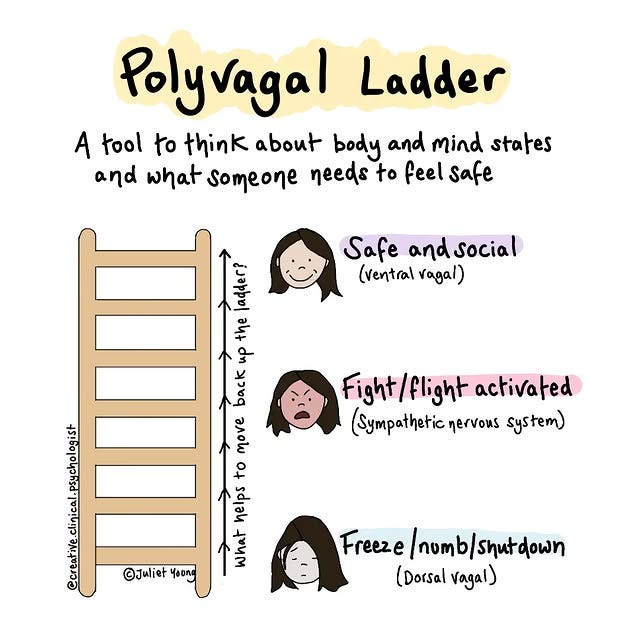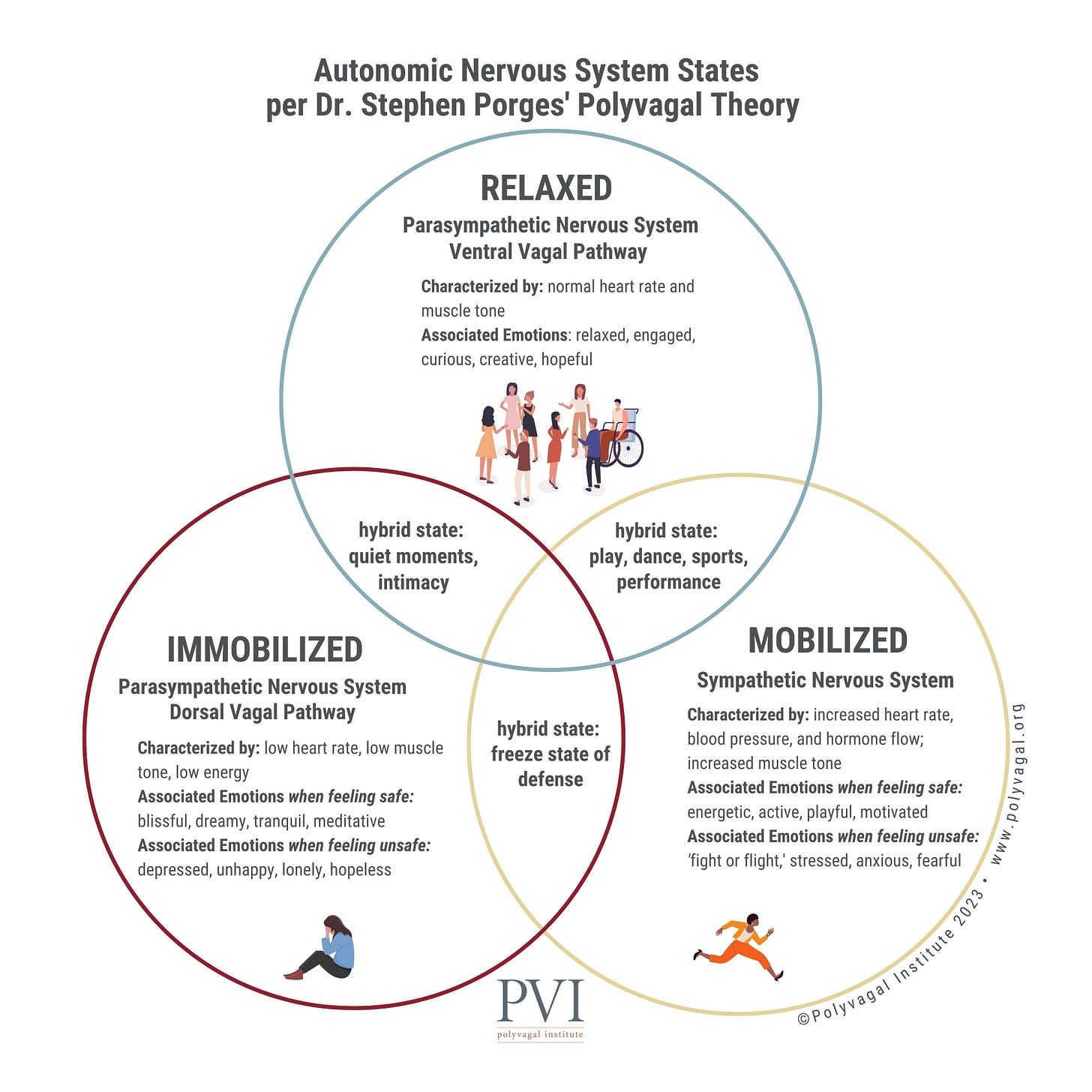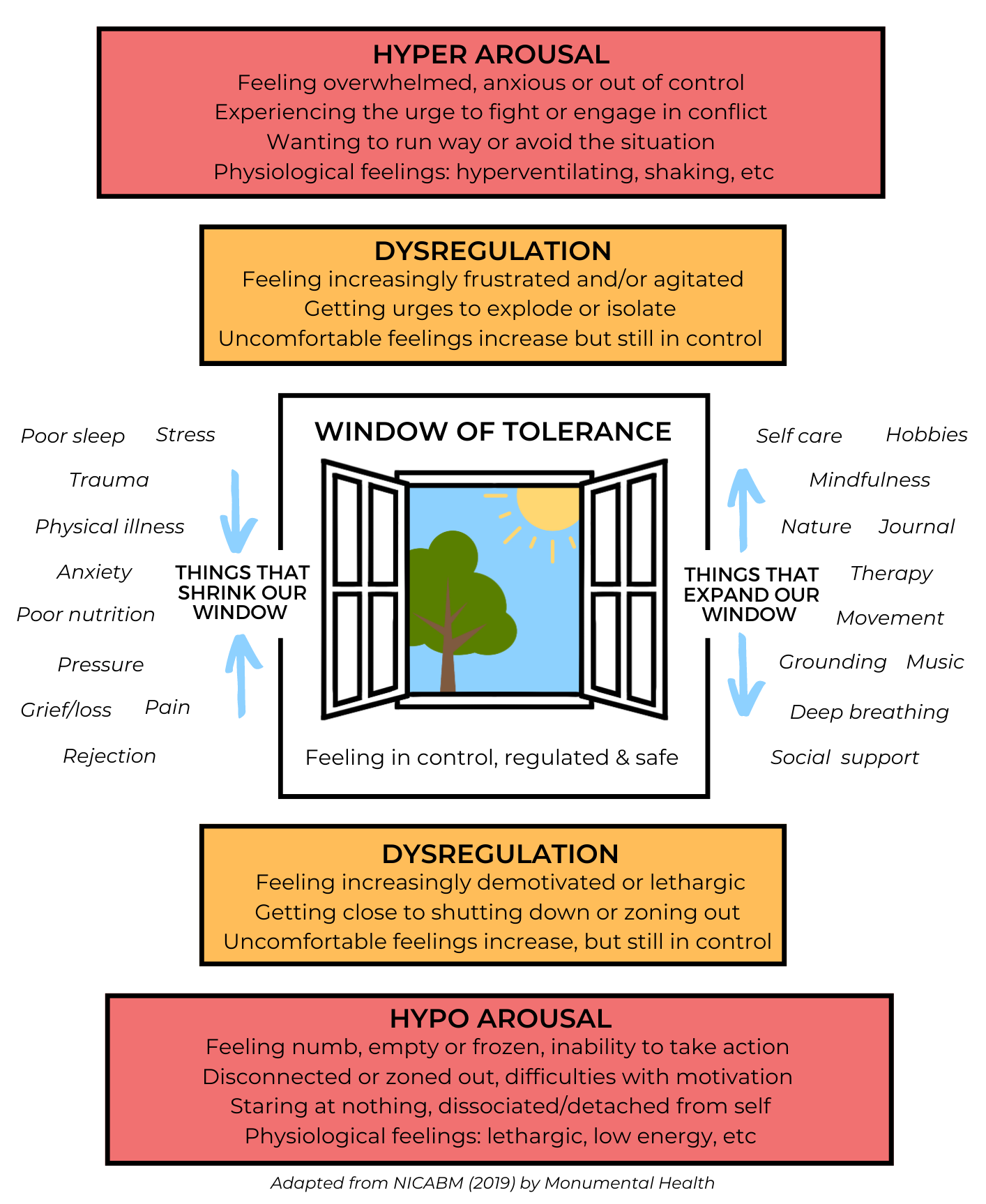Polyvagal Theory: What Is It and Should CBT Therapists Pay Attention?
As polyvagal theory dominates therapy social media and reddit threads, CBT therapists face a crucial question: does this trending framework offer valuable insights for evidence-based practice?
What is Polyvagal Theory?
Polyvagal theory, developed by Stephen Porges, focuses on how the vagus nerve - extending from brainstem to internal organs - influences our stress responses and emotional states1. The theory proposes different branches of this nerve mediate various stress responses, from feeling safe and socially engaged, to states of fight-flight-freeze.
The Polyvagal Ladder describes three states: ventral vagal, sympathetic stress response and dorsal vagal.
Therapists incorporating polyvagal theory pay attention to which state the client feels they are in, and work with it as a physiological response as well as a psychological state. This may include work such as somatic experiencing2.
Rather than a protocol or therapeutic modality, polyvagal is a theoretical approach that can be applied to any therapeutic modality or diagnosis. In particular, it can help clients understand how trauma stays within the body, particularly those who feel they are stuck in a state of immobilisation and disconnection3.
Should We Incorporate Polyvagal Into CBT?
Here's where it gets interesting: after 30 years, the scientific support remains limited.
Paul Grossman from University Hospital Basel explored the primary three evolutionary adaption premises underlying the theory, concluding that the physiological assumptions underlying polyvagal theory are untenable and indicate falsified hypotheses4.
Importantly, he concludes there is no support that the dorsal vagal motor nucleus may be responsible for trauma related dissociative or emotional freezing responses, as claimed by Porges5.
Despite the above, polyvagal remains discussed across social media, therapy websites, and is popular choice of understanding the nervous system for both therapists and clients.
Why Are Therapists And Clients Drawn to Polyvagal?
Despite scientific limitations, the theory's popularity reveals something important about current therapeutic approaches. It taps into what many feel is missing in traditional CBT: a framework for understanding body-mind connections that extends beyond the physical sensations element of formulations, PTSD interventions or general fight/flight psycho-education.
Anthony McCann PhD comments “What works in polyvagal work is already commonplace practice in trauma work. . . I find the conversation about polyvagal work helpful as a starting point for reflection”
In this way, perhaps it is useful for a meaningful discussion to help clients reflect on their changing emotional and physiological states.
However, McCann notes “but it’s increasingly not a scientific theory and more a belief system built around loyalty to a single person’s work”.
What This Means for Practice
According to Psychology Today's David J. Ley PhD, while learning about polyvagal theory may benefit clinicians, implementation requires careful consideration:
"Clinicians learning about PVT [polyvagal] is probably beneficial, though they should be aware of the limited overall support and conceptual problems that currently exist," he notes.
"The use of PVT in therapy is highly experimental at this point, and therapists should ethically communicate that to patients."
Finding Middle Ground
Rather than wholesale adoption or rejection, consider what the polyvagal trend reveals about potential gaps in current CBT practice:
Need for greater attention to physiological states
Value of understanding stress responses across diagnoses
Importance of body-based awareness in therapy
Indeed, polyvagal theory in its external claims, is not dissimilar to the Window of Tolerance coined by Dan Siegel in 1999 - a framework used for understanding physiological and emotional responses to stressors and reminders of past trauma6.
Perhaps the popularity of polyvagal theory suggests we should incorporate these ideas beyond trauma work.
Moving Forward
This debate suggests an opportunity to enhance CBT's "top-down" (working with thoughts and behaviours) approach with thoughtful integration of "bottom-up" physiological awareness - while maintaining our commitment to evidence-based practice.
It’s also important to note that the research continues to evolve - proponents of polyvagal theory are yet to respond to Grossman’s comments in any formal way - but we may see future debate and research.
Share your thoughts below: Do you incorporate polyvagal theory or other physiological awareness approaches in your CBT practice? What has been your experience?
Porges SW. The polyvagal theory: new insights into adaptive reactions of the autonomic nervous system. Cleve Clin J Med. 2009 Apr;76 Suppl 2(Suppl 2):S86-90. doi: 10.3949/ccjm.76.s2.17. PMID: 19376991; PMCID: PMC3108032.
https://traumahealing.org/
https://www.polyvagalinstitute.org/whatispolyvagaltheory
Paul Grossman, Fundamental challenges and likely refutations of the five basic premises of the polyvagal theory, Biological Psychology, Volume 180, 2023, 108589, ISSN 0301-0511, https://doi.org/10.1016/j.biopsycho.2023.108589.
Polyvagal Safety: Attachment, Communication, Self-Regulation: Stephen W. Porges. (Norton Series on Interpersonal Neurobiology) 5 Oct. 2021
Hershler, Abby. "Chapter 4 Window of Tolerance". Looking at Trauma: A Tool Kit for Clinicians, edited by Abby Hershler, Lesley Hughes, Patricia Nguyen and Shelley Wall, University Park, USA: Penn State University Press, 2021, pp. 25-28. https://doi.org/10.1515/9780271092287-008




